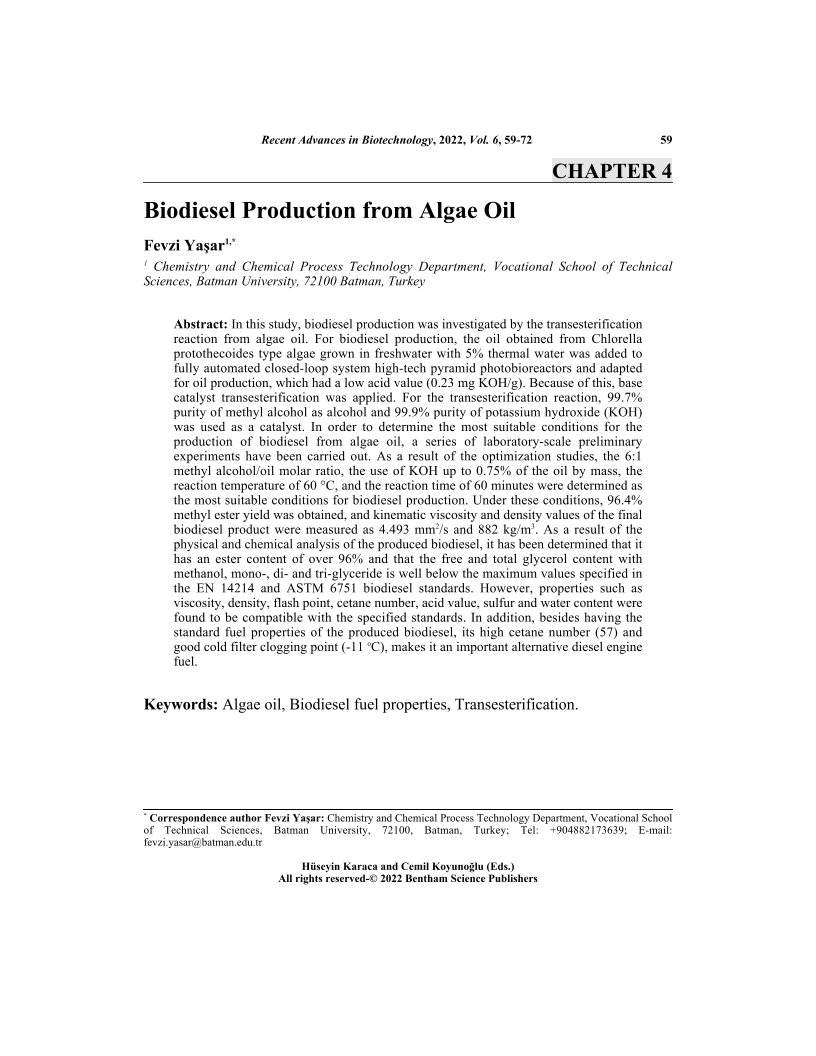Biodiesel Production from Algae Oil

- By Fevzi Yaşar1
-
View Affiliations Hide Affiliations1 Chemistry and Chemical Process Technology Department, Vocational School of TechnicalSciences, Batman University, 72100 Batman, Turkey
- Source: Algal Biotechnology for Fuel Applications , pp 59-72
- Publication Date: October 2022
- Language: English
Biodiesel Production from Algae Oil, Page 1 of 1
< Previous page | Next page > /docserver/preview/fulltext/9789815051001/chap4-1.gif
In this study, biodiesel production was investigated by the transesterification reaction from algae oil. For biodiesel production, the oil obtained from Chlorella protothecoides type algae grown in freshwater with 5% thermal water was added to fully automated closed-loop system high-tech pyramid photobioreactors and adapted for oil production, which had a low acid value (0.23 mg KOH/g). Because of this, base catalyst transesterification was applied. For the transesterification reaction, 99.7% purity of methyl alcohol as alcohol and 99.9% purity of potassium hydroxide (KOH) was used as a catalyst. In order to determine the most suitable conditions for the production of biodiesel from algae oil, a series of laboratory-scale preliminary experiments have been carried out. As a result of the optimization studies, the 6:1 methyl alcohol/oil molar ratio, the use of KOH up to 0.75% of the oil by mass, the reaction temperature of 60 °C, and the reaction time of 60 minutes were determined as the most suitable conditions for biodiesel production. Under these conditions, 96.4% methyl ester yield was obtained, and kinematic viscosity and density values of the final biodiesel product were measured as 4.493 mm2/s and 882 kg/m3. As a result of the physical and chemical analysis of the produced biodiesel, it has been determined that it has an ester content of over 96% and that the free and total glycerol content with methanol, mono-, di- and tri-glyceride is well below the maximum values specified in the EN 14214 and ASTM 6751 biodiesel standards. However, properties such as viscosity, density, flash point, cetane number, acid value, sulfur and water content were found to be compatible with the specified standards. In addition, besides having the standard fuel properties of the produced biodiesel, its high cetane number (57) and good cold filter clogging point (-11 oC), makes it an important alternative diesel engine fuel.
-
From This Site
/content/books/9789815051001.chap4dcterms_subject,pub_keyword-contentType:Journal -contentType:Figure -contentType:Table -contentType:SupplementaryData105

